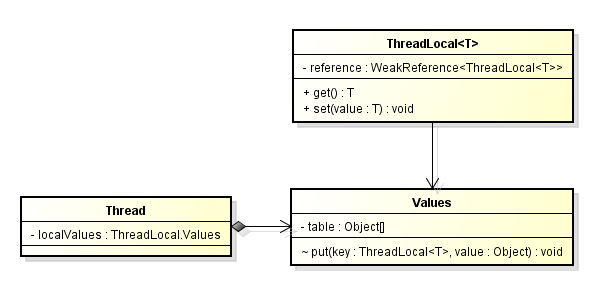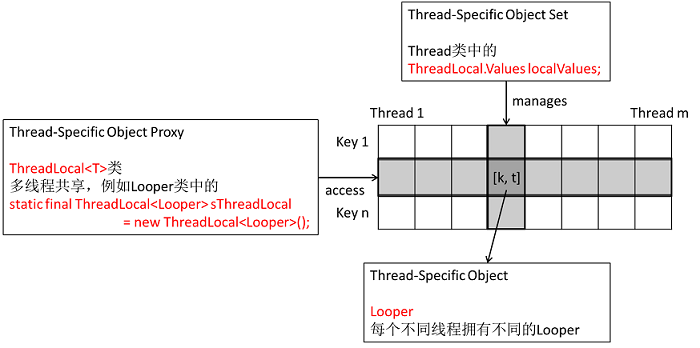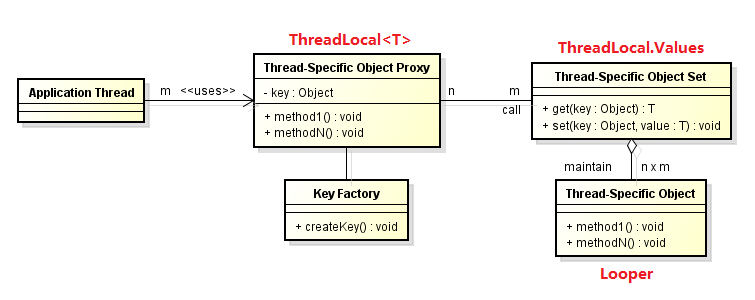1. 如何创建Looper?
Looper的构造方法为private,所以不能直接使用其构造方法创建。
private Looper(boolean quitAllowed) {
mQueue = new MessageQueue(quitAllowed);
mThread = Thread.currentThread();
}要想在当前线程创建Looper,需使用Looper的prepare方法,Looper.prepare()。
如果现在要我们来实现Looper.prepare()这个方法,我们该怎么做?我们知道,Android中一个线程最多只能有一个Looper,若在已有Looper的线程中调用Looper.prepare()会抛出RuntimeException(“Only one Looper may be created per thread”)。面对这样的需求,我们可能会考虑使用一个HashMap,其中Key为线程ID,Value为与线程关联的Looper,再加上一些同步机制,实现Looper.prepare()这个方法,代码如下:
public class Looper {
static final HashMap<Long, Looper> looperRegistry = new HashMap<Long, Looper>();
private static void prepare() {
synchronized(Looper.class) {
long currentThreadId = Thread.currentThread().getId();
Looper l = looperRegistry.get(currentThreadId);
if (l != null)
throw new RuntimeException("Only one Looper may be created per thread");
looperRegistry.put(currentThreadId, new Looper(true));
}
}
...
}上述方法对Looper.class对象进行了加锁,这些加锁开销有可能造成性能瓶颈。
有没有更好的方法实现Looper.prepare()方法?看一看Android的中Looper的源码。
public class Looper {
static final ThreadLocal<Looper> sThreadLocal = new ThreadLocal<Looper>();
public static void prepare() {
prepare(true);
}
private static void prepare(boolean quitAllowed) {
if (sThreadLocal.get() != null) {
throw new RuntimeException("Only one Looper may be created per thread");
}
sThreadLocal.set(new Looper(quitAllowed));
}
...
}prepare()方法中调用了ThreadLocal的get和set方法,然而整个过程没有添加同步锁,Looper是如何实现线程安全的?
2. ThreadLocal
ThreadLocal位于java.lang包中,以下是JDK文档中对该类的描述
Implements a thread-local storage, that is, a variable for which each thread has its own value. All threads share the same ThreadLocal object, but each sees a different value when accessing it, and changes made by one thread do not affect the other threads. The implementation supports null values.
大致意思是,ThreadLocal实现了线程本地存储。所有线程共享同一个ThreadLocal对象,但不同线程仅能访问与其线程相关联的值,一个线程修改ThreadLocal对象对其他线程没有影响。
ThreadLocal为编写多线程并发程序提供了一个新的思路。如下图所示,我们可以将ThreadLocal理解为一块存储区,将这一大块存储区分割为多块小的存储区,每一个线程拥有一块属于自己的存储区,那么对自己的存储区操作就不会影响其他线程。对于ThreadLocal<Looper>,则每一小块存储区中就保存了与特定线程关联的Looper。
3. ThreadLocal的内部实现原理
3.1 Thread、ThreadLocal和Values的关系
Thread的成员变量localValues代表了线程特定变量,类型为ThreadLocal.Values。由于线程特定变量可能会有多个,并且类型不确定,所以ThreadLocal.Values有一个table成员变量,类型为Object数组。这个localValues可以理解为二维存储区中与特定线程相关的一列。
ThreadLocal类则相当于一个代理,真正操作线程特定存储区table的是其内部类Values。

3.2 set方法
public void set(T value) {
Thread currentThread = Thread.currentThread();
Values values = values(currentThread);
if (values == null) {
values = initializeValues(currentThread);
}
values.put(this, value);
}
Values values(Thread current) {
return current.localValues;
}既然与特定线程相关,所以先获取当前线程,然后获取当前线程特定存储,即Thread中的localValues,若localValues为空,则创建一个,最后将value存入values中。
void put(ThreadLocal<?> key, Object value) {
cleanUp();
// Keep track of first tombstone. That's where we want to go back
// and add an entry if necessary.
int firstTombstone = -1;
for (int index = key.hash & mask;; index = next(index)) {
Object k = table[index];
if (k == key.reference) {
// Replace existing entry.
table[index + 1] = value;
return;
}
if (k == null) {
if (firstTombstone == -1) {
// Fill in null slot.
table[index] = key.reference;
table[index + 1] = value;
size++;
return;
}
// Go back and replace first tombstone.
table[firstTombstone] = key.reference;
table[firstTombstone + 1] = value;
tombstones--;
size++;
return;
}
// Remember first tombstone.
if (firstTombstone == -1 && k == TOMBSTONE) {
firstTombstone = index;
}
}
}从put方法中,ThreadLocal的reference和值都会存进table,索引分别为index和index+1。
对于Looper这个例子,
table[index] = sThreadLocal.reference;(指向自己的一个弱引用)
table[index + 1] = 与当前线程关联的Looper。
3.3 get方法
public T get() {
// Optimized for the fast path.
Thread currentThread = Thread.currentThread();
Values values = values(currentThread);
if (values != null) {
Object[] table = values.table;
int index = hash & values.mask;
if (this.reference == table[index]) {
return (T) table[index + 1];
}
} else {
values = initializeValues(currentThread);
}
return (T) values.getAfterMiss(this);
}首先取出与线程相关的Values,然后在table中寻找ThreadLocal的reference对象在table中的位置,然后返回下一个位置所存储的对象,即ThreadLocal的值,在Looper这个例子中就是与当前线程关联的Looper对象。
从set和get方法可以看出,其所操作的都是当前线程的localValues中的table数组,所以不同线程调用同一个ThreadLocal对象的set和get方法互不影响,这就是ThreadLocal为解决多线程程序的并发问题提供了一种新的思路。
4. ThreadLocal背后的设计思想Thread-Specific Storage模式
Thread-Specific Storage让多个线程能够使用相同的”逻辑全局“访问点来获取线程本地的对象,避免了每次访问对象的锁定开销。
4.1 Thread-Specific Storage模式的起源
errno机制被广泛用于一些操作系统平台。errno 是记录系统的最后一次错误代码。对于单线程程序,在全局作用域内实现errno的效果不错,但在多线程操作系统中,多线程并发可能导致一个线程设置的errno值被其他线程错误解读。当时很多遗留库和应用程序都是基于单线程编写,为了在不修改既有接口和遗留代码的情况下,解决多线程访问errno的问题,Thread-Specific Storage模式诞生。
4.2 Thread-Specific Storage模式的总体结构
线程特定对象,相当于Looper。
线程特定对象集包含一组与特定线程相关联的线程特定对象。每个线程都有自己的线程特定对象集。相当于ThreadLocal.Values。线程特定对象集可以存储在线程内部或外部。Win32、Pthread和Java都对线程特定数据有支持,这种情况下线程特定对象集可以存储在线程内部。
线程特定对象代理,让客户端能够像访问常规对象一样访问线程特定对象。如果没有代理,客户端必须直接访问线程特定对象集并显示地使用键。相当于ThreadLocal<Looper>。
从概念上讲,可将Thread-Specific Storage的结构视为一个二维矩阵,每个键对应一行,每个线程对应一列。第k行、第t列的矩阵元素为指向相应线程特定对象的指针。线程特定对象代理和线程特定对象集协作,向应用程序线程提供一种访问第k行、第t列对象的安全机制。注意,这个模型只是类比。实际上Thread-Specific Storage模式的实现并不是使用二维矩阵,因为键不一定是相邻整数。
参考资料
- Thread-local storage
- 面向模式的软件架构·卷2:并发和联网对象模式




























 6688
6688

 被折叠的 条评论
为什么被折叠?
被折叠的 条评论
为什么被折叠?








